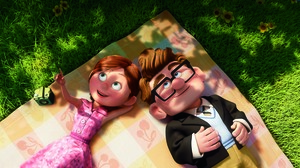Pixar’s latest film surprisingly grounded in reality

Up, up and away · Seventy-eight-year-old Carl Fredrickson lives his childhood dream of adventuring when he attaches thousands of balloons to his house and sets sail for South America. Unbeknownst to Carl, he is accompanied by 8-year-old Russell and a colorful cast of characters. Photos Courtesy of Buena Vista Pictures
No one compares to John Lasseter and his staff at Pixar.
It’s an exhausted statement, one that is uttered every time the Emeryville, Calif.-based studio releases a film in theaters; yet as its 10th feature-length film is a flawless affair of vibrancy and vivacity, it seems Pixar is still reaching for its highest peak — as always.
Arriving on the tailwind of “WALL-E,” Pixar’s last innovation that garnered an Academy Award (and many more nominations), is “Up,” the studio’s most recent eccentric masterpiece.
Just when critics and ordinary filmgoers alike thought no other film could match that droopy-eyed robot and his quest for love, “Up” has just upped the animation ante.
Though the film delivers no new advancements in technology aside from being Pixar’s first 3-D venture, “Up” quickly earned its cinematic street cred — even prior to its release last Friday — when it became the first-ever animated film to open the Cannes Film Festival. There, the film gained more buzz than many of its live-action peers, including Quentin Tarantino’s “Inglourious Basterds.”
And with good reason.
What “Up” brings to the celluloid table is exquisite storytelling, an attentive focus on detail and an incredibly endearing, heartfelt character on which everything else so gratefully relies. Really, “Up” would not be nearly as affecting without its strongly crafted main protagonist.
When we first meet Carl Fredrickson, he’s a young child with frizzy red hair, missing teeth and much-too-large Urban Outfitter-chic glasses. He is positively giddy while sitting in a Depression-era movie theater, viewing a film on Charles Muntz, a widely respected explorer vaguely fashioned after Charles Lindberg.
Proudly sporting Muntz-inspired flight cap and goggles, Carl’s passion for adventuring is only sparked more when he encounters the spunky, fast-talking Ellie, a fellow aspiring adventurer with matching adventurer attire — it’s a matchmade in Pixar heaven.
Once again, the animators at Pixar prove they are masters of visual storytelling, for no words are needed to grasp the connection between Carl and Ellie. Instead of expositional dialogue, the audience is given a bittersweet montage set to a hauntingly beautiful waltz, unveiling a simple love story that is tainted with unexpected loss and missed opportunities. By the end of Carl and Ellie’s ballad, one’s face is stained with tears — and the film has barely reached its 10-minute mark.
Now, and for the remainder of the film, Carl is a 78-year-old misanthropic widower, living alone in the dream house Ellie and he built, accompanied only by his memories and tennis ball-adorned walker.
Both physically and emotionally fragile in his old age, Carl is in danger of losing his colorful house to the money-grubbing housing company usurping the neighborhood with its monochromatic skyscrapers — a notion with which Carl cannot live.
And so, “Up” takes off, sailing through the tendrils of imagination as effortlessly as thousands upon thousands of balloons sail a two-story house past skyscrapers. While what follows never quite reaches the opening sequence’s emotional apex, “Up” is colorful, zany and completely unexpected.

Young Carl and his wife, Ellie, relax while on a picnic. An emotionally powerful montage at the film’s beginning of “Up” depicts Carl and Ellie’s life together, from their first kiss to their last days. Photos Courtesy of Buena Vista Pictures
Included in the unexpected is Russell, a young and pudgy adventure scout (voiced by scene-stealer Jason Nagai) who finds himself a stowaway on Carl’s floating house after trying so desperately to receive his “aiding the elderly” badge.
While Carl is a man hardened by pain, living his life so unerringly guarded, Russell also has some pain of his own, despite for having such a short life. Yet Russell is able to openly deal with his emotions, a skill he inadverdently imposes on Carl. While he’s irritating, Russell is the one person who can crack Carl’s stoic shell — a heartwarming pleasure to watch.
Coupled with these emotional lows, of course, are the highs. Humor is found everywhere, from the naive yet well-intentioned Russell to the multicolored (female) bird that Russell hilariously misnames “Kevin” and the clingy mutt named “Dug” that would do anything for his master’s approval — unless, of course, there’s a squirrel nearby.
To say Pixar transcends the animated film genre would only degrade the genre, automatically labeling it as a lesser art form than live-action film. For what exactly makes an animated film? Any studio executive would tell you talking animals, a formulaic, three-part adventure and lots of slapstick humor. In recent years, the genre has been solely associated with children, and their ticket sales have become the targeted demographic.
“Up,” however, rounds out Pixar’s “grown-up” triumvirate, which also includes “Ratatouille” and the aforementioned “WALL-E.” Audacious and unconventional, poignant and witty — these films truly do not have a targeted audience in mind, and this is most refreshing about Pixar.
Lasseter and the rest never seem to write stifled by page count, sell-ability or turning point. Gimmick is not in their vocabulary; neither is formula. It is a rarity among the films Hollywood churns out these days, and Pixar is lucky enough to have the money and brand-name recognition to stick to its gut feelings and make what it wants to make — an enviable creative freedom it has yet to abuse.
You’re not going to the movies to see an animated film — you’re going to see a good story. “Up” is an excellent reminder that there’s no distinction between the two.
